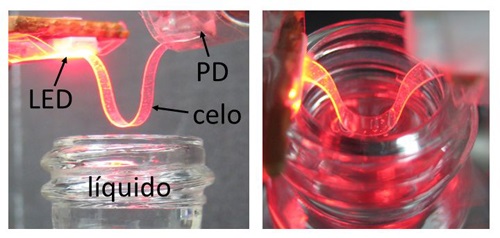2016-12-09
Researchers from UPM have developed a low-cost, easy-to-implement and flexible optical sensor that provides great advantages compared to other optical devices.
Within a project of the BBVA Foundation Grants for Researchers and Cultural Creators 2015, researchers from Universidad Politécnica de Madrid (UPM) have developed an innovative optical sensor using a conventional tape since it is a low-cost and flexible material that can be easily acquired at stationery shops and it can detect variations of the optical properties of a liquid when is immersed in such liquid. The developed sensor can be used to control both the quality of beverages and environmental monitoring.
The sensor consists of a waveguide using a piece of tape where light from a LED is introduced in one of its end and the light that comes out from the other end is detected through a photodiode. The light coupling to the flexible waveguide is possible thanks to a diffractive element, using a grating with aluminum lines of nano dimensions which is added to the tape through a simple process of “tear and paste”. Both ends of the waveguide can be easily adhered to the emitter (LED) and the light detector (photodiode).
Because of the flexibility of the tape, the waveguide can bend and is partially immersed in the liquid under examination. Due to the waveguide bending, part of the propagated light is lost by radiation. This curvature loss depends on the optical properties, in particular the refractive index, of the surrounding medium, in this case the liquid in which the waveguide is introduced. Thus, it is possible to detect variations of the refractive index of the liquid by measuring with the photodiode the optical power lost during the path of light through the immersed waveguide.
The refractive index of a liquid solution is related to its both physical and chemical properties such as density and concentration. Thus, we can assess, for example, the maturation degree of the grape by measuring the refractive index of its juice or the alcoholic content of certain beverages. In this way, the developed sensor can be applied to the food sector (process control and beverage quality) and the environmental sector (water quality control).
The materials and components used to develop this sensor are common and inexpensive. Besides, the assembly of the three main components of the sensor: waveguide, LED and photodiode, is simple and there is no need of instrumentation or specialized tools, therefore the assembly can be carried out by non-qualified personnel.
Dr. Carlos Angulo Barrios, the lead researcher for this project, “these features, along with the flexibility of the tape, make this sensor very advantageous regarding other optical instruments for the detection of refractive index more complex, rigid and expensive, especially in field applications and on-site analysis of liquids in areas of difficult access”.
Carlos Angulo Barrios is a researcher at the Institute of Optoelectronics Systems and Microtechnology (ISOM) and a professor at Department of Photonics Technology and Bioengineering (TFB) of the School of Telecommunications Engineering of UPM.
Barrios, C.A. “Rapid on-site formation of a free-standing flexible optical link for sensing applications”. SENSORS, vol. 16 (1643), pp. 1-11, 2016.
Barrios, C.A.; Canalejas-Tejero, V. “Compact discs as versatile cost-effective substrates for releasable nanopatterned aluminium films. NANOSCALE, vol. 7, pp. 3435–3439, 2015.













